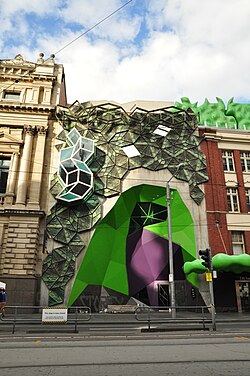|
Storey Hall
Storey Hall, located at 342–344 Swanston Street in Melbourne, Australia, is part of the RMIT City campus of the Royal Melbourne Institute of Technology (RMIT University). It consists of a grand meeting hall constructed in 1887, extended and renovated in 1996, providing a large upper hall, the lower hall as home to RMIT Gallery First Site, and a range of lecture theatres and seminar rooms. HistoryThe hall was built by the Hibernian-Australasian Catholic Benefit Society, formed in 1885, for the local Irish Catholic community, and called Hibernian Hall.[1] The architects were Tappin, Gilbert & Dennehy, and the contractors were O'Dea & Kennedy, and it opened to great fanfare in November 1887.[2] There was a meeting room and offices downstairs, and a large hall upstairs, complete with gallery, and the facade features a high rusticated base, and giant order Corinthian columns above, all executed in fine stone. The Society ran into difficulties and had to sell in 1903, and by 1907 it was known as the Guild Hall, used for art exhibitions, a cinema and as a wrestling venue.[1] From 1917-1919 it was occupied by the Women's Political Association, dedicated to women's suffrage and other political reforms,[3] and became a commune to support wharf workers during the 1917 General Strike. It was purchased Royal Melbourne Institute of Technology (now RMIT University) in 1957.[4] In 1959 the hall was named after the Storey family; Sir John Storey (Senior), who left a large bequest to RMIT in order to found the John Storey Junior Memorial Scholarships in memory of his son, and John Storey (Junior), who founded the RMIT Student Union in 1944, and whose studies were cut short in 1947 when he died of leukaemia at age 22.[5] A major refurbishment of the hall, and a large addition to the south was completed in 1996 to the design of Ashton Raggatt McDougall. The ground level of the original hall houses the RMIT First Site Gallery, which is operated by the RMIT Union, and has a focus on new media, as well as a cafe named re:vault.[6] ArchitectureOne of the key influences in the design of the Storey Hall annex is the use of Penrose’s tiling pattern, developed by Roger Penrose.[7] The street façade is a version of the historic hall next door, its basic shapes of arch below and window above transformed by applying the Penrose pattern. The precast Penrose patterned tiles incorporate the impression of ruffles, keys and suspender belts to represent the suffragettes of the Women's Political Association. The colours of purple and green also reflect those of the women's liberation movement, with the green, used more extensively inside, referring to the Hibernian Hall’s construction by the Irish community of Melbourne.[8] The foyer contains off-form concrete walls and columns with a curved stairwell. The main auditorium’s ceiling and large areas of wall are composed of geometric Penrose tile patterns in green and white. Storey Hall is both architecturally and historically significant as it has won numerous awards and combines both the historical and traditional aspects of the former Hibernian Hall to create a complex and daring building. Storey Hall could be said to represent the Deconstructivism strain of postmodern architecture, and contrasts for instance with the more ordered and facade of RMIT Building 8 on the other side of Storey Hall. The Storey Hall refurbishment was one of the first buildings in Melbourne to use computer and digital fabrication, necessary to produce the complex yet mathematical elements of the architecture.[9] Gallery
AwardsRAIA National Interior Architecture Award, 1996[9] RAIA Victorian Architecture Medal, 1996[9] RAIA William Wardell Award for Institutional Architecture, 1996[9] RAIA Marion Mahony Award for Interior Architecture, 1996[9] National Award – Dulux Colour Awards, 1996[9] Notes
References
External linksWikimedia Commons has media related to Storey Hall. |
||||||||||||||||||||||||||||||||||
Portal di Ensiklopedia Dunia










